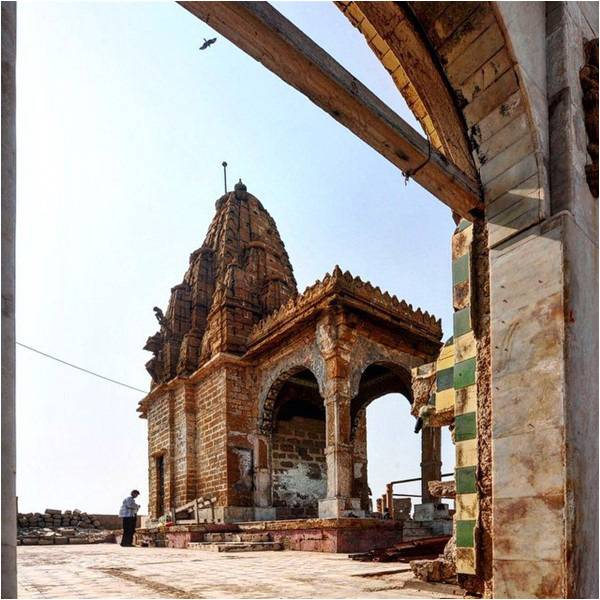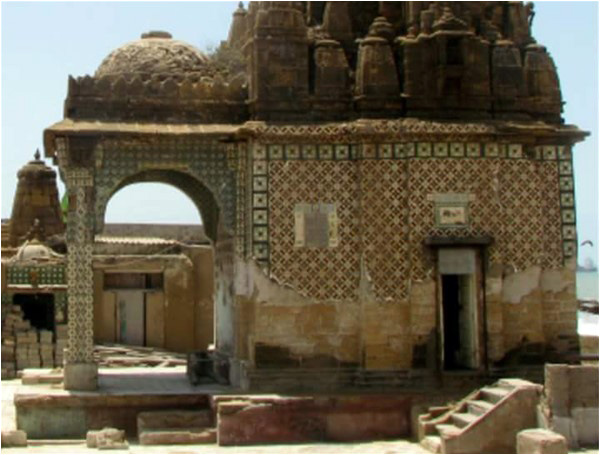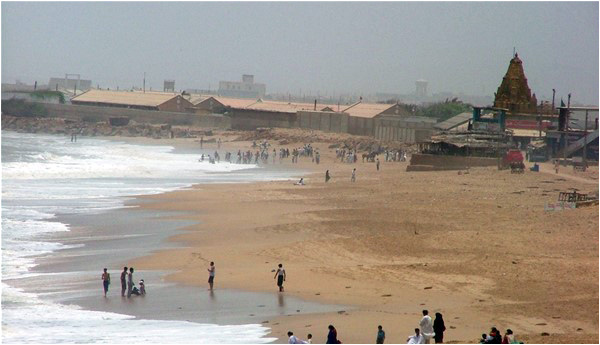
Shri Varun Dev temple complex is located on Manora Island near Karachi. It is appropriately dedicated to Varun, the Hindu deity associated with waters and rain. The temple stands towering over the island, overlooking the vast sea expanse with its range of activities – from fishing to transport and from trade to defence. The presence of the temple on the island lends the place an air of being witnessed through the centuries: a landscape that is being engulfed in masses of concrete. Even the sea that lapped the feet of the temple once has been cordoned off by a wall, no longer able to pay homage to the looming deity.
According to legend, Bhojomal Nancy Bhattia, a sailor, bought the island from the Khan of Kalat around the 16th century and built the temple on what then would have been mostly vacant ground. It is widely believed that the current structure was renovated around 1917–18. Certainly, there are features that appear older and then some that are relatively more recent.

Over the years, the temple fell into neglect and disrepair, its stone eroded by winds and water and its carvings, sculpture and other decorations suffering harm. Then in the aftermath of the Babri Masjid attack in India, the temple was vandalised in ‘retaliation’ and the figures on its beautiful tile-work were mutilated. One stands there wondering how such delicate beauty was deliberately defiled. One piece of tile-work that depicted people in the foreground being overlooked by a peacock with a trailing tail, with scenes from a town receding in the background, today has the people gashed out. It is as if a hustling and bustling city was invaded and its people butchered – leaving only its remains and a peacock that is stunned into disbelief!
The rehabilitation project of Sindh Exploration and Adventure Society (SEAS) headed by its president Dr. Kaleemullah Lashari, former secretary of the Sindh Department of Antiquities and Dr. Asma Ibrahim, renowned archaeologist and museologist, received a grant of $250,000 from the US Ambassador’s Fund for Cultural Preservation.
The resurrected temple officially opened its doors on the 25th of January with a ceremony attended by a large number of people. Earlier, it had been revived for worship in 2015
I visited the temple early in January this year. Entering the Kiamari harbour was like stepping into the pages of a history book going back and forth. The first thing that catches the eye is the British period structures. Immediately the space fills with the ghosts of faces gathered to welcome friends and family or bid them goodbye – a crossing-point for life’s throbbing action. The pavilion looked similar to the Lahore City Heritage Museum building – an awning in a port city connecting an awning in the heart of Punjab, conjuring up a map of the remains of the Raj.
Stepping into the boat and heading for the sea was such a liberating experience. With the pleasant weather, cool breezes, calm waters and flights of seagulls around, all seemed well with the world – I chose to ignore obvious signs of unthinking development and securitized muscle flexing. The mind can create its own landscape through selective focus.
Landing on the Island transports one to a different world. The scene is laid out with large capstans strewn on the ground, waiting to get back into the sea. As one walks through the narrow high street a glimpse of the temple’s spire is seen beckoning the feet that seek it.
The temple itself is a delight. It has regained its sparkling albeit damaged beauty. The priests and pilgrims have returned for the first time after the1950s. The temple is living again.

The island of Manora is a microcosm of the history, cultural diversity and interfaith harmony that characterised this part of the world for centuries. On this island we find a Hindu temple, a Sikh Gurdwara, a church, a mosque and a Sufi shrine. Guru Nanak is believed to have visited the Varun temple. There are many Nanak Panthis on this island: Hindus who regard Nanak as their Guru and place his portrait in their temples, alongside other deities.
The Varun temple contains two other shrines – one to Jhule Lal and the other to Shiva. Jhule Lal is believed to be an incarnation of Varun and is usually represented sitting crosslegged on a lotus, balanced on a palla fish swimming in the Indus River. Sindhis, as is common knowledge, derive their name from Sindhu (Indus). Lal Shehbaz Qalandar of Sehwan Sharif is also called Jhule Lal and I was wondering whether the Pashto word for rain, ‘baaraan’, has any link with Varun. The web of historical, geographical and literary syncretism that joins all these faiths and the people of Pakistan can be felt on this island. No matter how much anybody denies that which exists historically, it only amounts to self-denial, since history does not live only in textbooks. It lives in the very ground we walk upon and the waters that nourish us, the words we use and the stories we understand.
The local community, comprising Hindus, Muslim, Sikhs and Christians have enthusiastically participated in the rehabilitation and opening of the temple. The SEAS team trained local craftspersons for the purpose. These craftspeople are now in great demand and have also been employed for the embellishment of the new Islamabad airport. The Sindh department of Minorities Affairs, the Pakistan Hindu Council, the Sindh Department of Antiquities, culture and tourism, the advisory committee for Sindh Cultural Heritage and the naval authorities all cooperated with this project and all have a stake in its sustainability.
Over the years, there had been many alterations and additions to the temple complex by devotees. During the years of neglect three families lived there and they added many structures for their own convenience. The SEAS team prepared a comprehensive plan for rehabilitation including documentation, screening the additions/alterations, dating and noting which parts were in danger of falling. An interesting discovery was the origin of many of the beautiful tiles. According to the project’s newsletter, many of these were dated from the period 1920s to 1941. This is because they bear the stamp, ‘Made in Japan’. Before the 1920s glazed tiles were supplied to India by British factories. During the Depression following the First World War, Japan entered the Indian market for tiles and started by supplying British copies. Soon they adapted to local tastes as well and began manufacturing tiles depicting local themes including religious ones and brighter colours. During the Second World War an embargo was imposed on Japanese goods, so these stopped entering the market in 1941.
The dating can be done through various embellishments that indicate the fashions during various periods of history. There are also commemorative plaques put up by devotees who contributed to the temple in memory of their loved ones. The sculpture at the head of the entrance door marks one of the oldest parts of the temple. Most of the deities have disappeared.
Now that the temple is fully restored, its life and vibrancy will return. Already it has become the scene of celebrations like Holi and Diwali. Like Sleeping Beauty’s castle, the temple will again be populated by the memory of all those who sought blessings there. The pictures on its tiles will start retelling their old tales. New people will arrive with new hopes and the temple’s spire will catch the rays of a new dawn.
According to legend, Bhojomal Nancy Bhattia, a sailor, bought the island from the Khan of Kalat around the 16th century and built the temple on what then would have been mostly vacant ground. It is widely believed that the current structure was renovated around 1917–18. Certainly, there are features that appear older and then some that are relatively more recent.

Over the years, the temple fell into neglect and disrepair, its stone eroded by winds and water and its carvings, sculpture and other decorations suffering harm. Then in the aftermath of the Babri Masjid attack in India, the temple was vandalised in ‘retaliation’ and the figures on its beautiful tile-work were mutilated. One stands there wondering how such delicate beauty was deliberately defiled. One piece of tile-work that depicted people in the foreground being overlooked by a peacock with a trailing tail, with scenes from a town receding in the background, today has the people gashed out. It is as if a hustling and bustling city was invaded and its people butchered – leaving only its remains and a peacock that is stunned into disbelief!
The rehabilitation project of Sindh Exploration and Adventure Society (SEAS) headed by its president Dr. Kaleemullah Lashari, former secretary of the Sindh Department of Antiquities and Dr. Asma Ibrahim, renowned archaeologist and museologist, received a grant of $250,000 from the US Ambassador’s Fund for Cultural Preservation.
The resurrected temple officially opened its doors on the 25th of January with a ceremony attended by a large number of people. Earlier, it had been revived for worship in 2015
On this island we find a Hindu temple, a Sikh Gurdwara, a church, a mosque and a Sufi shrine. Guru Nanak is also believed to have visited the Varun temple
I visited the temple early in January this year. Entering the Kiamari harbour was like stepping into the pages of a history book going back and forth. The first thing that catches the eye is the British period structures. Immediately the space fills with the ghosts of faces gathered to welcome friends and family or bid them goodbye – a crossing-point for life’s throbbing action. The pavilion looked similar to the Lahore City Heritage Museum building – an awning in a port city connecting an awning in the heart of Punjab, conjuring up a map of the remains of the Raj.
Stepping into the boat and heading for the sea was such a liberating experience. With the pleasant weather, cool breezes, calm waters and flights of seagulls around, all seemed well with the world – I chose to ignore obvious signs of unthinking development and securitized muscle flexing. The mind can create its own landscape through selective focus.
Landing on the Island transports one to a different world. The scene is laid out with large capstans strewn on the ground, waiting to get back into the sea. As one walks through the narrow high street a glimpse of the temple’s spire is seen beckoning the feet that seek it.
The temple itself is a delight. It has regained its sparkling albeit damaged beauty. The priests and pilgrims have returned for the first time after the1950s. The temple is living again.

The island of Manora is a microcosm of the history, cultural diversity and interfaith harmony that characterised this part of the world for centuries. On this island we find a Hindu temple, a Sikh Gurdwara, a church, a mosque and a Sufi shrine. Guru Nanak is believed to have visited the Varun temple. There are many Nanak Panthis on this island: Hindus who regard Nanak as their Guru and place his portrait in their temples, alongside other deities.
The Varun temple contains two other shrines – one to Jhule Lal and the other to Shiva. Jhule Lal is believed to be an incarnation of Varun and is usually represented sitting crosslegged on a lotus, balanced on a palla fish swimming in the Indus River. Sindhis, as is common knowledge, derive their name from Sindhu (Indus). Lal Shehbaz Qalandar of Sehwan Sharif is also called Jhule Lal and I was wondering whether the Pashto word for rain, ‘baaraan’, has any link with Varun. The web of historical, geographical and literary syncretism that joins all these faiths and the people of Pakistan can be felt on this island. No matter how much anybody denies that which exists historically, it only amounts to self-denial, since history does not live only in textbooks. It lives in the very ground we walk upon and the waters that nourish us, the words we use and the stories we understand.
The local community, comprising Hindus, Muslim, Sikhs and Christians have enthusiastically participated in the rehabilitation and opening of the temple. The SEAS team trained local craftspersons for the purpose. These craftspeople are now in great demand and have also been employed for the embellishment of the new Islamabad airport. The Sindh department of Minorities Affairs, the Pakistan Hindu Council, the Sindh Department of Antiquities, culture and tourism, the advisory committee for Sindh Cultural Heritage and the naval authorities all cooperated with this project and all have a stake in its sustainability.
Over the years, there had been many alterations and additions to the temple complex by devotees. During the years of neglect three families lived there and they added many structures for their own convenience. The SEAS team prepared a comprehensive plan for rehabilitation including documentation, screening the additions/alterations, dating and noting which parts were in danger of falling. An interesting discovery was the origin of many of the beautiful tiles. According to the project’s newsletter, many of these were dated from the period 1920s to 1941. This is because they bear the stamp, ‘Made in Japan’. Before the 1920s glazed tiles were supplied to India by British factories. During the Depression following the First World War, Japan entered the Indian market for tiles and started by supplying British copies. Soon they adapted to local tastes as well and began manufacturing tiles depicting local themes including religious ones and brighter colours. During the Second World War an embargo was imposed on Japanese goods, so these stopped entering the market in 1941.
The dating can be done through various embellishments that indicate the fashions during various periods of history. There are also commemorative plaques put up by devotees who contributed to the temple in memory of their loved ones. The sculpture at the head of the entrance door marks one of the oldest parts of the temple. Most of the deities have disappeared.
Now that the temple is fully restored, its life and vibrancy will return. Already it has become the scene of celebrations like Holi and Diwali. Like Sleeping Beauty’s castle, the temple will again be populated by the memory of all those who sought blessings there. The pictures on its tiles will start retelling their old tales. New people will arrive with new hopes and the temple’s spire will catch the rays of a new dawn.

